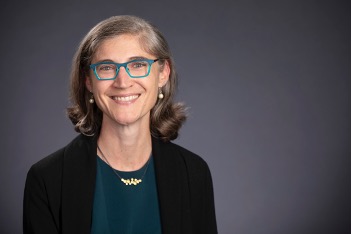This week, IEN explores what instructional coaching with teachers look like from “micro-“ and “macro-perspectives.” This post is the first in a series featuring excerpts of interviews with presenters participating in the Educational Change Special Interest Group sessions at the upcoming Annual Conference of the American Educational Research Association in Philadelphia in April. This post includes presenters from the session titled: “A Roundtable Discussion to Examine a Synthesis of Micro- to Macro-level Coaching Research.” These interviews are part of the Lead the Change series produced by AERA’s Educational Change Special Interest Group. The full interviews can be found on the LtC website. The LtC series is produced by Alex Lamb.
The Micro-level Work of Coaching: Examining the Content and Purpose of Coach-Teacher Interactions — Lynsey Gibbons, University of Delaware, Abby Reisman, University of Pennsylvania
LtC: The 2024 AERA theme is Dismantling Racial Injustice and Constructing Educational Possibilities: A Call to Action. How does your research respond to this call?
Lyndsey Gibbons & Abby Reisman (LG & AR): Instructional coaching has been widely utilized as a strategy both for school reform and improving learning opportunities for students by providing teachers with ongoing, job-embedded professional learning (Darling-Hammond et al., 2017). Instructional coaches are uniquely positioned to assist teachers to develop justice-oriented teaching that works toward transforming personal and power relationships in classrooms, as well as support them to interrogate the larger policies and practices of schooling (Duncan-Andrade & Morrell, 2008). One way coaches do this is through supporting teachers to understand and respond to the roles of language, identity, culture, and power in learning (Baldinger, 2017; Marshall & Buenrostro, 2021). Coaches can also support teachers to interrogate policies and practices and make changes when they produce inequities or cause harm.
The larger theory of action of instructional coaching rests on resources that are made available to teachers through social interactions with coaches (Coburn & Russell, 2008). Coaching is job-embedded in nature, and coaches can take an active role in the work of teaching. As such, coaches can orchestrate professional interactions that make visible the complex reasoning work in justice-oriented teaching (Saclarides & Munson, 2021), such as considering when to ask a student to revoice another student’s contribution and the implications of such a choice. Professional discourse is central to how teachers learn and shapes what they have an opportunity to learn (Lefstein et al., 2020). Professional discourse is essential for productive discussions about justice-oriented teaching and learning because it allows teachers and coaches to name critical aspects of instructional practice and student learning. Coaches can help establish professional discourse to name aspects of teaching and help make it visible to teachers.
Professional discourse is essential for productive discussions about justice-oriented teaching and learning.
Particular features of social interactions can be more or less conducive to accessing appropriate resources and creating a normative environment that supports and enables change in teachers’ instructional practices. In our session, we will explore the features of coach-teacher interactions that provide productive learning opportunities to teachers. For example, we found that history teachers whose coaches focused on posing open-ended questions and anticipating students’ responses grew more in their discussion facilitation than teachers whose coaches focused on historical thinking skills. Identifying features of coach-teacher interactions is critical to supporting the professional learning of coaches, as well as researching the effectiveness of coaching. Guiding questions for our roundtable discussion include: How can coach-teacher interactions be shaped to consider how to dismantle racial injustice in the classroom and beyond? How do coaches’ orientations toward teacher learning and toward justice influence their interactions with teachers? We then will consider how we might craft a research agenda moving forward that attends to examining coaching interactions that support teacher learning.
LtC: What are some of the ideas you hope the field of Educational Change and the audience at AERA can learn from your work related to practice, policy, and scholarship?
In this session, we are intentionally bringing together scholars who study teacher learning, instructional coaching practice, and policies that impact coaching. By design, we will be examining practice and policies around coaching, as well as consider future directions for scholarship. The workgroup will break into three smaller groups to grapple with the logics, conceptualizations, and visions that shape their work researching coaching. The smaller groups will identify research gaps and consider new approaches. For example, a gap that might be identified is how coaches can help teachers attend to students’ identities and strengths as they plan for and enact instruction, as well as how coaches can help teachers learn to navigate the social and political dimensions of teaching (Marshall & Buenrostro, 2021). We then will come back together as a whole workgroup to synthesize discussions across domains to consider future, potentially collaborative, research agendas. We hope this session will be the genesis of long-term conversations organizing scholars who study coaching. Stemming from these initial conversations could be considerations for a special issue in a journal or creating a practitioner-facing document informing policies around coaching.
Widening Our Lens to Consider Coaching Models and Programs: The Benefits and Challenges of Programmatic Thinking — Jacy Ippolito, Salem State University, Rita M. Bean, University of Pittsburgh
Lead the Change (LtC): The 2024 AERA theme is Dismantling Racial Injustice and Constructing Educational Possibilities: A Call to Action. How does your research respond to this call?
Jacy Ippolito & Rita M. Bean (JI & RMB): Our joint work has traditionally focused on the roles, responsibilities, and impact of instructional coaches (and literacy coaches specifically) across grade levels and school settings. In our latest book (Ippolito & Bean, 2024), we propose a new framework for understanding and synthesizing coaching research findings. The framework is an initial response to the Kraft et al. (2018) meta-analysis call to identify effective elements of coaching programs with simultaneous attention paid to both specific instructional practices and larger school and district contexts. Towards this end, our Content and Context Framework (CCF) for coaching reframes the notion of effective coaching. Instead of thinking of coaching success as solely the product of individual coaches’ work, we instead detail the ways in which coaching efficacy may be more accurately described as the alignment of instructional content with coaching programs and processes, all within a supportive school and district context.
This more content- and context-dependent way of thinking about coaching success paves the way for coaches, teachers, and leaders to identify more clearly the ways in which issues of equity, diversity, and racial justice are influenced by coaching in schools. If coaching work is unable to influence the instructional core by creating more equitable opportunities and outcomes for all students, then we might be hard-pressed to say that the coaching program is successful. Likewise, if school and district contexts (i.e., leadership structures, coaching policies, systematic evaluations of coaching) are unable to fully support a coaching program that has diversity and equity as a core mission, again we might be unable to call a coaching program entirely successful.
If coaching work is unable to influence the instructional core by creating more equitable opportunities and outcomes for all students, then we might be hard-pressed to say that the coaching program is successful.
As we have begun to look across the past ten years of coaching research (Bean & Ippolito, 2023)—literacy coaching specifically, as well as research on instructional coaching more broadly—we found very few studies to date address content, coaching, and context simultaneously (e.g., Galey-Horn, 2020; Zoch, 2015). If alignment of these three domains is what we hypothesize may provide the best opportunities to address issues of equity and to dismantle racial injustice in classrooms, then we must incentivize future coaching researchers to attend carefully to content, coaching, and context together in larger-scale studies. Implications of this work are far-ranging, from influencing future research to shifting the ways that coaching programs are constructed, refined, and evaluated over time.
LtC: What are some of the ideas you hope the field of Educational Change and the audience at AERA can learn from your work related to practice, policy, and scholarship?
JI & RMB: Instructional coaching has long been heralded as a gold standard for job-embedded professional learning for educators (Kraft et al., 2018). At its best, coaching is: personalized; responsive to teachers’ needs; attentive to school and district needs; sensitive to students’ unique learning successes and challenges; and implemented over long periods of time to help teachers shift instructional practices in meaningful ways. However, coaching research suggests that many coaching programs do not quite live up to their promise of supporting broad and deep changes in teaching and learning.
Our Content and Context Framework (CCF) for coaching suggests that part of the reason that many coaching programs do not fully succeed is due to a misalignment or inattention to content, coaching, and context simultaneously. For example, when all three elements are aligned, coaches can provide content-specific guidance to teachers that furthers schools’ and districts’ goals while simultaneously supporting teachers’ own identified needs. In cases where content, coaching, and context are misaligned, coaches and teachers’ work may run counter to school and district goals, and/or school or district needs (e.g., for coaches to step in as classroom substitutes) may subvert coaching work completely. A number of implications arise from our framework’s suggestion that coaching success results from the alignment of purpose and practices across content, coaching, and context.
For researchers, the implications of this framework include conducting studies that focus equally on classroom-level teaching and learning, coaching practices, and school/district contextual factors. Smaller-scale studies of individual coaches and/or coaching programs can be mined for guidance on the direction and questions of larger-scale longitudinal studies and meta-analyses. Future coaching research, regardless of scale, may best serve the field by always including: (a) data collected from and about teachers’ and students’ work in classrooms; (b) coaching practices and collaborations with both teachers and leaders; and (c) information collected from/about school and district leaders, school/district policies, and related coaching and professional learning initiatives. Such comprehensive research on coaching work—attending equally to content, coaching, and context—is what the field most needs to support future policy and practice.
For U.S. policymakers, implications include providing better guidance to schools, districts, and states about the interdependence of content, coaching, and context. Coaching guidance can no longer be provided as if content- and context-factors were neutral or irrelevant. Based on emerging content- and context-specific coaching research (e.g., Hannan & Russell, 2020), policymakers may be better equipped to provide funding and guidance to support the success of coaching practices best suited to different disciplinary initiatives (e.g., coaching practices within literacy vs. math initiatives) and different contexts (e.g. within large urban school districts vs. smaller rural districts). Ultimately, we must move away from one-size-fits-all policies for coaching, and instead move towards more nuanced content- and context-dependent guidance.
Finally, for practicing coaches and leaders, our framework suggests that the development, refinement, and evaluation of coaching programs must consider the alignment (or misalignment) of content, coaching, and context. This suggests that teachers, coaches, and leaders must partner even more closely to define coaching roles, responsibilities, and routines. School and district leaders must work with coaches to develop role descriptions, coaching schedules, and menus of service that are content- and context-specific. Finally, coaches and teachers must develop common communication and collaboration practices that are content- and context-specific, to meet teachers’ and students’ needs most effectively.
The 30,000 Foot View: Mapping the Institutional Landscape of Coaching — Sarah L. Woulfin, University of Texas at Austin
Lead the Change (LtC): The 2024 AERA theme is Dismantling Racial Injustice and Constructing Educational Possibilities: A Call to Action. How does your research respond to this call?
Sarah L. Woulfin (SLW): My research responds to this year’s AERA theme by paying close attention to how infrastructure and leadership shape instructional reform efforts in ways that exacerbate—or disrupt—inequities in educational organizations. For instance, my research on the policies and practices of coaching has explored how district and school leaders structure and conceptualize coaching as a tool for reaching equity-oriented objectives. I’m currently co-facilitating professional development sessions for principals and coaches on equity-oriented coaching. And my research on the implementation of turnaround reform considers how school leaders promote curriculum use to improve outcomes for Black and Brown students.
The daily practices of leaders and teachers can ‘add up’ to make significant changes.
LtC: What are some of the ideas you hope the field of Educational Change and the audience at AERA can learn from your work related to practice, policy, and scholarship?
SLW: One major branch of my work addresses the role of people in the implementation of education policy. In particular, the daily practices of leaders and teachers can “add up” to make significant changes. I hope the AERA and Educational Change audiences devote more attention to the power of and possibilities for individuals to catalyze crucial change to improve schools and communities. Additionally, the field should consider how to support the policy knowledge development of educators ranging from district leaders and principals to coaches and teachers. That is, how do we ensure that all educators hold the capacity to analyze and ask needed questions about reforms they are experiencing.
LtC: What excites you about the direction of the field of Educational Change, and how might we share and develop those ideas at AERA 2024?
SLW: I am excited about the ways the Educational Change field is examining a wide array of policies and programs, including discipline, attendance, school counseling, and EdTech in addition to accountability-oriented and instructional reforms. I believe this points to the utility of an Educational Change perspective for analyzing numerous aspects of districts and schools. And I encourage featuring scholarship that expands our understanding of educational change while looking at diverse reform efforts.
References (Gibbons & Reisman):
Baldinger, E. M. (2017). Maybe it’s a status problem”: Development of mathematics teacher noticing for equity. In E. O. Schack, J. Wilhelm, & M. H. Fisher (Eds.), Teacher noticing: Bridging and broadening perspectives, contexts, and frameworks (pp. 231–250). Springer.
Biancarosa, G., Bryk, A. S., & Dexter, E. R. (2010). Assessing the value-added effects of literacy collaborative professional development on student learning. The Elementary School Journal, 111(1), 7-34.
Coburn, C. E., & Russell, J. L. (2008). District policy and teachers’ social networks. Educational Evaluation and Policy Analysis, 30(3), 203-235.
Darling-Hammond, L., Hyler, M. E., & Gardner, M. (2017). Effective teacher professional development. Learning Policy Institute.
Duncan-Andrade, J. M. R., & Morrell, E. (2008). The art of critical pedagogy: Possibilities for moving from theory to practice in urban schools (Vol. 285). Peter Lang.
Ippolito, J. & Bean, R. (2024). The Power of Instructional Coaching in Context: A Systems View for Aligning Content and Coaching. The Guilford Press.
Kazemi, E., Granger, J. C., Lind, T., Lewis, R., Resnick, A. F., Gibbons, L. K. (in preparation). Children Thrive When Teachers Thrive. Harvard Education Press.
Kraft, M. A., Blazar, D., & Hogan, D. (2018). The effect of teacher coaching on instruction and achievement: A meta analysis of the causal evidence. Review of Educational Research, 88(4), 547-588.
Lefstein, A., Louie, N., Segal, A., & Becher, A. (2020). Taking stock of research on teacher collaborative discourse: Theory and method in a nascent field. Teaching and Teacher Education, 88, 102954.
Marshall, S. A., & Buenrostro, P. M. (2021). What makes mathematics teacher coaching effective? A call for a justice-oriented perspective. Journal of Teacher Education, 72(5), 594-606.
Robertson, D. A., Padesky, L. B., Ford Connors, E., & Paratore, J. R. (2020). What does it mean to say coaching is relational?. Journal of Literacy Research, 52(1), 55 – 78.
Saclarides, E. S., & Munson, J. (2021). Exploring the foci and depth of coach teacher interactions during modeled lessons. Teaching and Teacher Education, 105, 103418.
References (Ippolito & Bean):
Bean, R. M., & Ippolito, J. (2023, December). Interactions of content, coaching, and context in recent literacy coaching research. Presented at the Annual Meeting of the Literacy Research Association (LRA), Atlanta, GA.
City, E. A., Elmore, R. F., Fiarman, S. E., & Teitel, L. (2009). Instructional rounds in education. Harvard Education Press.
Galey-Horn, S. (2020). Capacity-building for district reform: The role of instructional coach teams. Teachers College Record, 122(10), 1-40.
Hannan, M. Q., & Russell, J. L. (2020). Coaching in context: Exploring conditions that shape instructional coaching practice. Teachers College Record, 122(10), 1–40. Ippolito, J., & Bean, R. M. (2024). The power of instructional coaching in context: A systems view



